Enhanced Long-Term In-Sensing Memory in ZnO Nanoparticle-Based Optoelectronic Synaptic Devices Through Thermal Treatment
Abstract
1. Introduction
2. Materials and Methods
2.1. Fabrication of Metal/ZnO NPs Thin Film/Metal Optoelectronic Synaptic Devices
2.2. Characterization of ZnO NPs-Based Optoelectronic Synaptic Devices
3. Results and Discussion
3.1. Effect of Thermal Annealing Conditions on Surface Morphology, Optical Properties, and Defect States of ZnO NPs Thin Films
3.2. XPS Analysis of ZnO NPs Thin Films: Effect of Thermal Annealing on Chemical States and Defect Formation
3.3. Effect of Thermal Annealing on Dark and UV Photoresponse in Al/ZnO NPs/Al Optoelectronic Synaptic Devices
3.4. Resistive Switching Behavior of Al/ZnO NPs/Al Optoelectronic Synaptic Devices: Influence of Thermal Annealing on Optical Set and Electrical Reset Processes
3.5. Short-Term Synaptic Plasticity in Al/ZnO NPs/Al Optoelectronic Synaptic Devices and the Influence of Thermal Annealing on Paired-Pulse Facilitation
3.6. Photostimulation-Dependent Synaptic Plasticity in ZnO NP-Based Optoelectronic Synaptic Devices and the Impact of Thermal Annealing on Memory Retention
3.7. Enhanced Learning and Memory Retention in ZnO NPs-Based Optoelectronic Synaptic Devices Through Thermal Annealing
4. Conclusions
Author Contributions
Funding
Institutional Review Board Statement
Informed Consent Statement
Data Availability Statement
Conflicts of Interest
References
- Jagan, S.M.; Simon, M.S.; Umesh, C.; Tseung, Y.T. Overview of Emerging Nonvolatile Memory Technologies. Nanoscale Res. Lett. 2014, 9, 526. [Google Scholar]
- Sagar, S.; Udaya, M.K.; Cho, S.; Majewski, L.A.; Das, B.C. Emulation of Synaptic Functions with Low Voltage Organic Memtransistor for Hardware Oriented Neuromorphic Computing. Sci. Rep. 2022, 12, 3808. [Google Scholar] [CrossRef] [PubMed]
- Shao, L.; Zhao, Y.; Liu, Y. Organic Synaptic Transistors: The Evolutionary Path from Memory Cells to the Application of Artificial Neural Networks. Adv. Funct. Mater. 2021, 31, 2101951. [Google Scholar] [CrossRef]
- Xu, Y.; Liu, Y.; Huang, Y.; Jin, C.; Zhou, B.; Sun, J.; Yang, J. Recent Advances in Flexible Organic Synaptic Transistors. Adv. Electron. Mater. 2021, 7, 2100336. [Google Scholar] [CrossRef]
- Chandra, R.D.; Gopchandran, K.G. Simple, Low-Temperature Route To Synthesize ZnO Nanoparticles and Their Optical Neuromorphic Characteristics. ACS Appl. Electron. Mater. 2021, 3, 3846. [Google Scholar] [CrossRef]
- Rosenbluth, D.; Kravtsov, K.; Fok, M.P.; Prucnal, P.R. A High Performance Photonic Pulse Processing Device. Opt. Express. 2009, 17, 22767. [Google Scholar] [CrossRef]
- Prucnal, P.R.; Shastri, B.J.; Ferreira, D.L.T.; Nahmias, M.A.; Tait, A.N. Recent Progress in Semiconductor Excitable Lasers for Photonic Spike Processing. Opt. Express. 2016, 8, 228–299. [Google Scholar] [CrossRef]
- Rao, D.; Pillai, A.I.K.; Garbrecht, M.; Saha, B. Scandium Nitride as a Gateway III-Nitride Semiconductor for Optoelectronic Artificial Synaptic Devices. Adv. Electron. Mater. 2022, 9, 2200975. [Google Scholar] [CrossRef]
- Kim, H.J.; Lee, S.H.; Jeon, D.B.; Lee, S.N. High-Performance Sol–Gel-Derived CNT-ZnO Nanocomposite-Based Photodetectors with Controlled Surface Wrinkles. Materials 2024, 17, 5325. [Google Scholar] [CrossRef]
- Lee, S.H.; Lee, H.J.; Jeon, D.B.; Kim, H.J.; Lee, S.N. Enhancing Long-Term Memory in Carbon-Nanotube-Based Optoelectronic Synaptic Devices for Neuromorphic Computing. Nanomaterials 2024, 14, 1501. [Google Scholar] [CrossRef]
- Yuste, M.; Escobar, G.R.; Martínez, S.O.; Mínguez, B.I.; Rodriguez, S.; Hernández, V.M.; Sánchez, O. Structural and Optical Characterization of Nanostructured ZnO Grown on Alumina Templates. Mater. Res. Express. 2014, 1, 045028. [Google Scholar] [CrossRef]
- Jangir, L.K.; Kumari, Y.; Kumar, A.; Kumar, M.; Awasthi, K. Investigation of Luminescence and Structural Properties of ZnO Nanoparticles, Synthesized with Different Precursors. Mater. Chem. Front. 2014, 1, 1413–1421. [Google Scholar] [CrossRef]
- Zhao, Y.; Cheng, L.; Xu, R.; Yu, Z.; Zhang, J. Research Progress and Applications of Optoelectronic Synaptic Devices Based on 2D Materials. Brain-X 2024, 2, e70004. [Google Scholar] [CrossRef]
- Talha, N. Synthesis and Characterization of 2D-TMDs MoS2/WS2 Thin Films/Flakes by Various Solution Processed Deposition Methods for Different Applications. Ph.D Thesis, Hamburg University of Technology, Hamburg, Germany, March 2021. [Google Scholar]
- Li, F.; Zhou, J.; Zhang, J.; Zhao, J. Research and Progress on Organic Semiconductor Power Devices. Materials 2024, 17, 3362. [Google Scholar] [CrossRef] [PubMed]
- Pham, Q.P.; Guyen, Q.N.L.; Nguyen, N.H.; Doan, U.T.; Ung, T.D.T.; Tran, V.C.; Phan, T.B.; Pham, A.T.T.; Pham, N.K. Calcination-dependent Microstructural and Optical Characteristics of Eco-Friendly Synthesized ZnO Nanoparticles and Their Implementation in Analog Memristor Application. Ceram. Int. 2023, 49, 20742. [Google Scholar] [CrossRef]
- Kim, J.H.; Choi, J.; Na, H.S.; Lee, S.N. High-Efficiency ZnO-Based Ultraviolet Photodetector with Integrated Single-Walled Carbon Nanotube Thin-Film Heater. Adv. Mater. Interface 2023, 10, 2300176. [Google Scholar] [CrossRef]
- Lee, H.J.; Kim, J.H.; Kim, H.J.; Lee, S.N. Improvements in Resistive and Capacitive Switching Behaviors in Ga2O3 Memristors via High-temperature Annealing Process. Materials 2024, 17, 2727. [Google Scholar] [CrossRef]
- Oh, J.-H.; Kim, J.-H.; Kim, H.-J.; Kim, Y.-H.; Kim, K.-K.; Lee, S.-N. Enhanced Long-Term Memory Properties of ZnO Nanoparticle-Based Optical Synaptic Devices for Neuromorphic Computing. Adv. Intell. Syst. 2023, 5, 2300350. [Google Scholar] [CrossRef]
- Bao, J.; Shalish, I.; Su, Z.; Gurwitz, R.; Capsso, F.; Wang, X.; Ren, Z. Photoinduced Oxygen Release and Persistent Photoconductivity in ZnO nanowires. Nanoscale Res. Lett. 2011, 6, 404. [Google Scholar] [CrossRef]
- Lee, H.-J.; Kim, J.-H.; Lee, S.-H.; Noh, T.; Ahn, S.-E.; Lee, S.-N. Ultraviolet to Red Wavelength-Dependent Gallium Oxide Memristor-Based Multi-Level Optoelectronic Synapse Device. J. Alloys Compd. 2025, 1017, 179053. [Google Scholar] [CrossRef]
- Wu, Q.; Wang, J.; Cao, J.; Lu, C.; Yang, G.; Shi, X.; Chuai, X.; Gong, Y.; Su, Y.; Zhao, Y.; et al. Photoelectric Plasticity in Oxide Thin Film Transistors with Tunable Synaptic Functions. Adv. Electron. Mater. 2018, 4, 1800556. [Google Scholar] [CrossRef]
- Zheng, H.; Liu, Y.; Sun, J. Micron-Sized Columnar Grains of CH3NH3PbI3 Grown by Solvent-Vapor Assisted Low-Temperature (75 °C) Solid-State Reac-Tion: The Role of Non-Coordinating Solvent-Vapor. Appl. Surf. Sci. 2018, 437, 82–91. [Google Scholar] [CrossRef]
- Singh, P.; Kumar, A.; Deepak; Kaur, D. ZnO Nanocrystalline Powder Synthesized by Ultrasonic Mist-Chemical Vapor Deposition. Opt. Mater. 2008, 30, 1316. [Google Scholar] [CrossRef]
- Sendi, R.K.; Mahmud, S. Effect of High-Oxygen Thermal Annealing on Structural, Electrical and Optical Properties of Undoped ZnO Discs Made from 40 nm ZnO Nanoparticles. Indian J. Phys. Proc. Indian Assoc. Cultiv. Sci. 2013, 87, 523–531. [Google Scholar] [CrossRef]
- Mekasuwandumrong, O.; Pawinrat, P.; Praserthdam, P.; Panpranot, J. Effects of Synthesis Conditions and Annealing Post-Treatment on the Photocatalytic Activities of ZnO Nanoparticles in the Degradation of Methylene Blue Dye. Chem. Eng. J. 2010, 164, 77–84. [Google Scholar] [CrossRef]
- Wang, Q.; Brier, M.; Joshi, S.; Puntambekar, A.; Chakrapani, V. Defect-Induced Burstein-Moss Shift in Reduced V2O5 Nanostructures. Phys. Rev. B 2016, 94, 245305. [Google Scholar] [CrossRef]
- Saw, K.G.; Aznan, N.M.; Yam, F.K.; Ng, S.S.; Pung, S.Y. New Insights on the Burstein-Moss Shift and Band Gap Narrowing in Indium-Doped Zinc Oxide Thin Films. PLoS ONE 2015, 10, e0141180. [Google Scholar] [CrossRef]
- Lin, B.; Fu, Z.; Jia, Y. Green Luminescent Center in Undoped Zinc Oxide Films Deposited on Silicon Substrates. Appl. Phys. Lett. 2001, 79, 943–945. [Google Scholar] [CrossRef]
- Vanheusden, K.; Seager, C.H.; Warren, W.L.; Tallant, D.R.; Voigt, J.A. Correlation between Photoluminescence and Oxygen Vacancies in ZnO Phosphors. Appl. Phys. Lett. 1996, 68, 403–405. [Google Scholar] [CrossRef]
- Dai, Y.; Zhang, Y.; Bai, Y.Q.; Wang, Z.L. Bicrystalline Zinc Oxide Nanowires. Chem. Phys. Lett. 2003, 375, 96–101. [Google Scholar] [CrossRef]
- Ajawfi, R.N.; Alam, M.J.; Raham, F.; Ahmad, S.; Shahee, A.; Kumar, S. Impact of Annealing on the Structural and Optical Properties of ZnO Nanoparticles and Tracing the Formation of Clusters via DFT Calculation. Arab. J. Chem. 2020, 13, 2207–2218. [Google Scholar] [CrossRef]
- Tu, Y.; Chen, S.; Li, X.; Gorbaciova, J.; Gillin, W.P.; Krause, S.; Briscoe, J. Impact of Annealing on the Structural and Optical Properties of ZnO Nanoparticles and Tracing the Formation of Clusters via DFT Calculation. Arab. J. Chem. 2020, 13, 2207–2218. [Google Scholar]
- Frankcombe, T.J.; Liu, Y. Interpretation of Oxygen 1s X-Ray Photoelectron Spectroscopy of ZnO. Chem. Mater. 2023, 35, 14. [Google Scholar] [CrossRef]
- Simanjuntak, F.M.; Panda, D.; Wei, K.H.; Tseng, T.Y. Status and Prospects of ZnO-Based Resistive Switching Memory Devices. Nanoscale Res. Lett. 2016, 11, 368. [Google Scholar] [CrossRef] [PubMed]
- Yin, Z.G.; Zhang, X.W.; Fu, Z.; Yang, X.L.; Wu, J.L.; Wu, G.S.; Gong, L.; Chu, P.K. Persistent Photoconductivity in ZnO Nanostructures Induced by Surface Oxygen Vacancy. Phys. Status Solidi A 2012, 6, 117–119. [Google Scholar] [CrossRef]
- Sharma, P.; Sreenivas, K.; Rao, K.V. Analysis of Ultraviolet Photoconductivity in ZnO Films Prepared by Unbalanced Magnetron Sputtering. J. Appl. Phys. 2003, 93, 3963–3970. [Google Scholar] [CrossRef]
- Xue, W.H.; Ci, W.J.; Xu, X.H.; Gang, L. Optoelectronic Memristor for Neuromorphic Computing. Chin. Phys. B 2020, 4, 048401. [Google Scholar] [CrossRef]
- Lee, H.-J.; Kim, J.-H.; Lee, S.-H.; Lee, S.-N. Ga2O3-Based Optoelectronic Memristor and Memcapacitor Synapse for In-memory Sensing and Computing Applications. Nanomaterials 2024, 14, 1972. [Google Scholar] [CrossRef]
- Kim, J.-H.; Lee, H.-J.; Kim, H.-J.; Choi, J.; Oh, J.-H.; Choi, D.-C.; Byun, J.; Ann, S.-E.; Lee, S.-N. Oxide Semiconductor Memristor-based Optoelectronic Synaptic Devices with Quaternary Memory Storage. Adv. Electron. Mater. 2024, 10, 2300863. [Google Scholar] [CrossRef]
- Huang, M.; Ali, W.; Yang, L.; Huang, J.; Yao, C.; Xie, Y.; Sun, R.; Zhu, C.; Tan, Y.; Liy, X.; et al. Multifunctional Optoelectronic Synapses Based on Arrayed MoS2 Monolayers Emulating Human Association Memory. Adv. Sci. 2023, 10, 2300120. [Google Scholar] [CrossRef]
- Wang, Y.; Yin, L.; Huang, W.; Li, Y.; Huang, S.; Zhu, Y.; Yang, D.; Pi, X. Optoelectronic Synaptic Devices for Neuromorphic Computing. Adv. Intell. Syst. 2021, 3, 2000099. [Google Scholar] [CrossRef]
- Schmitt, R.; Kubicek, M.; Sediva, E.; Trassin, M.; Weber, M.C.; Rossi, A.; Hutter, H.; Kreisel, J.; Fiebig, M.; Rupp, J.L.M. Accelerated Ionic Motion in Amorphous Memristor Oxides for Nonvolatile Memories and Neuromorphic Computing. Adv. Funct. Mater. 2018, 29, 1804782. [Google Scholar] [CrossRef]
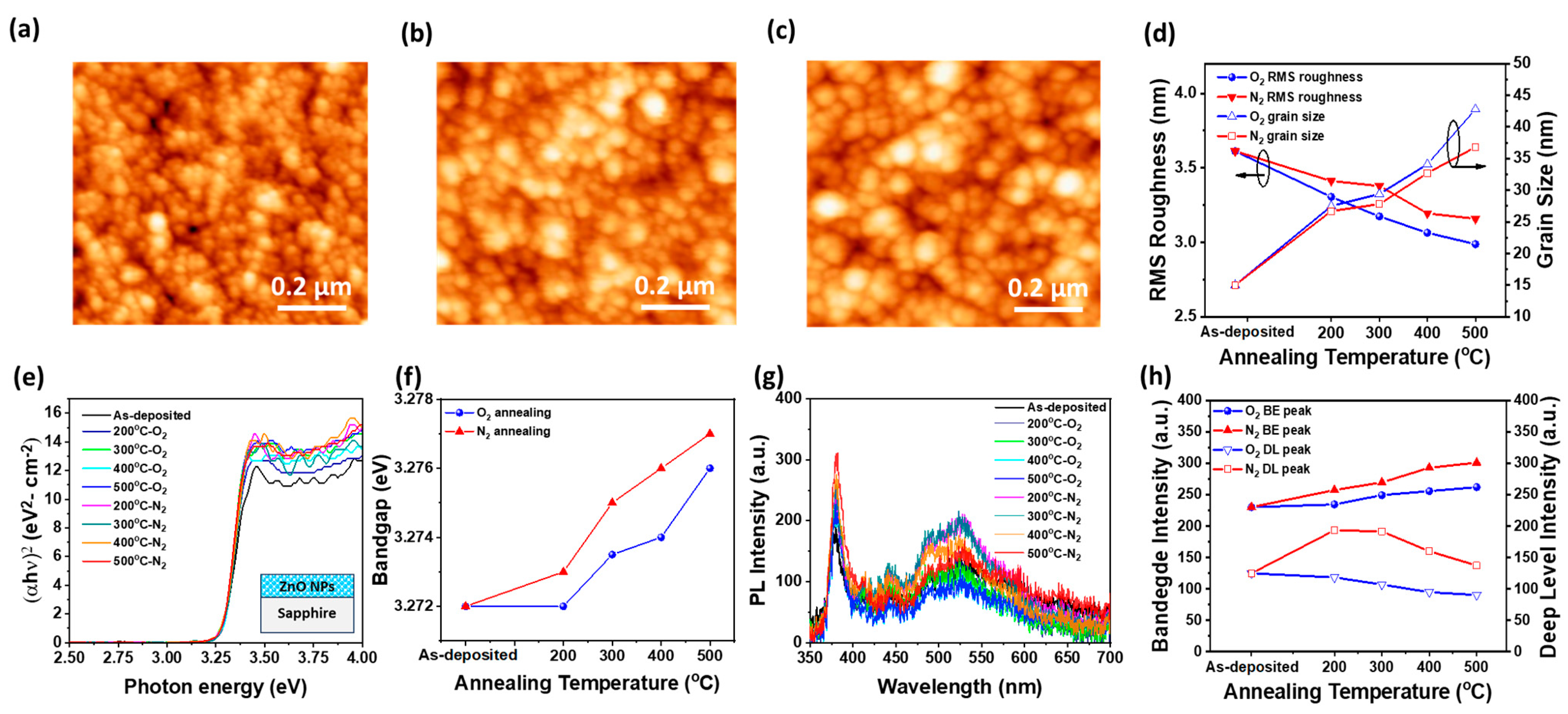
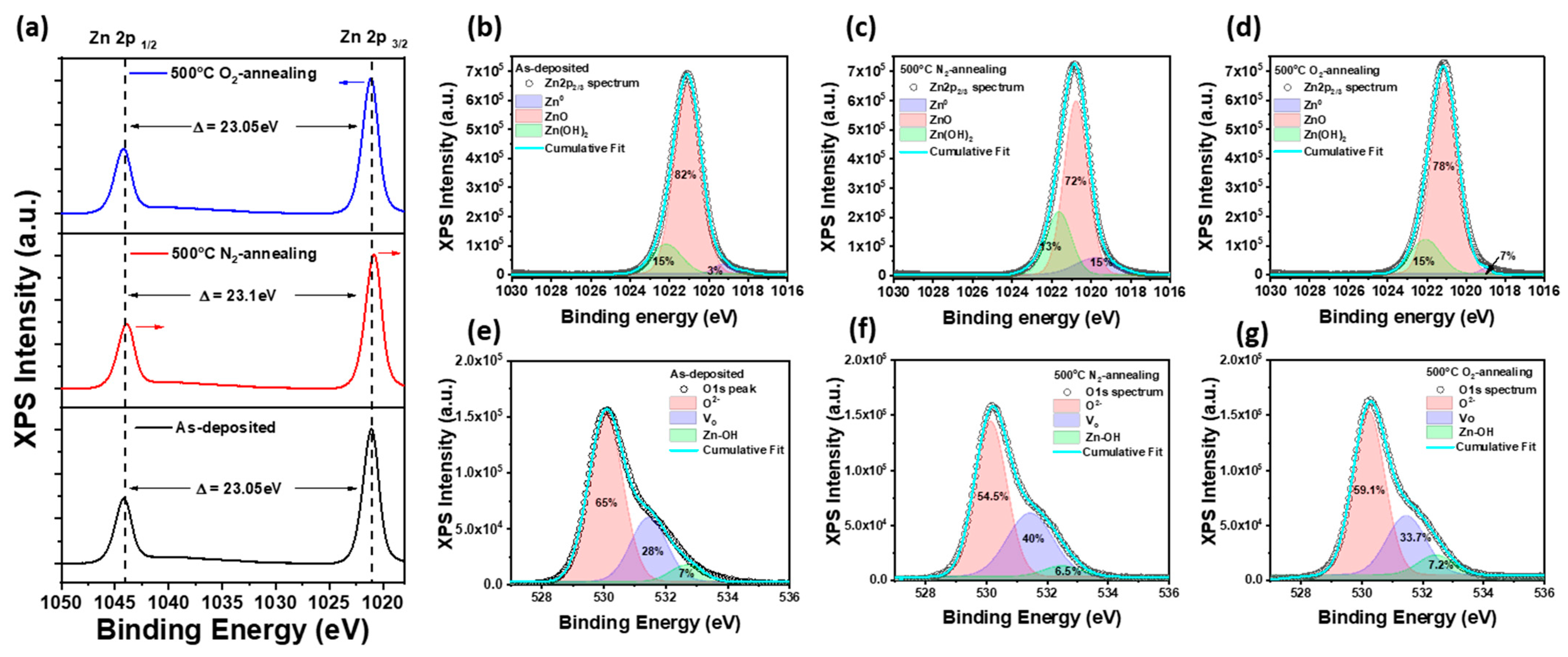
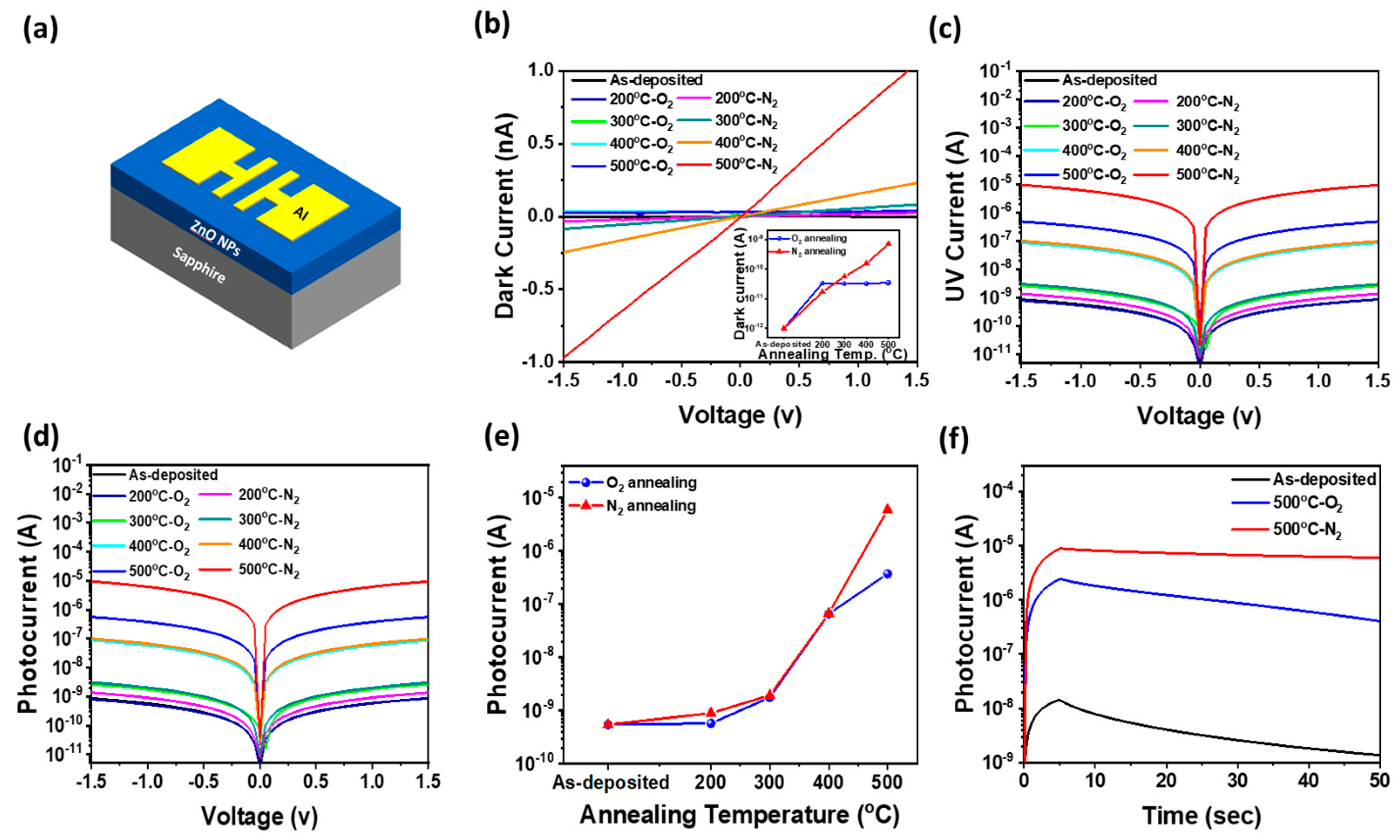
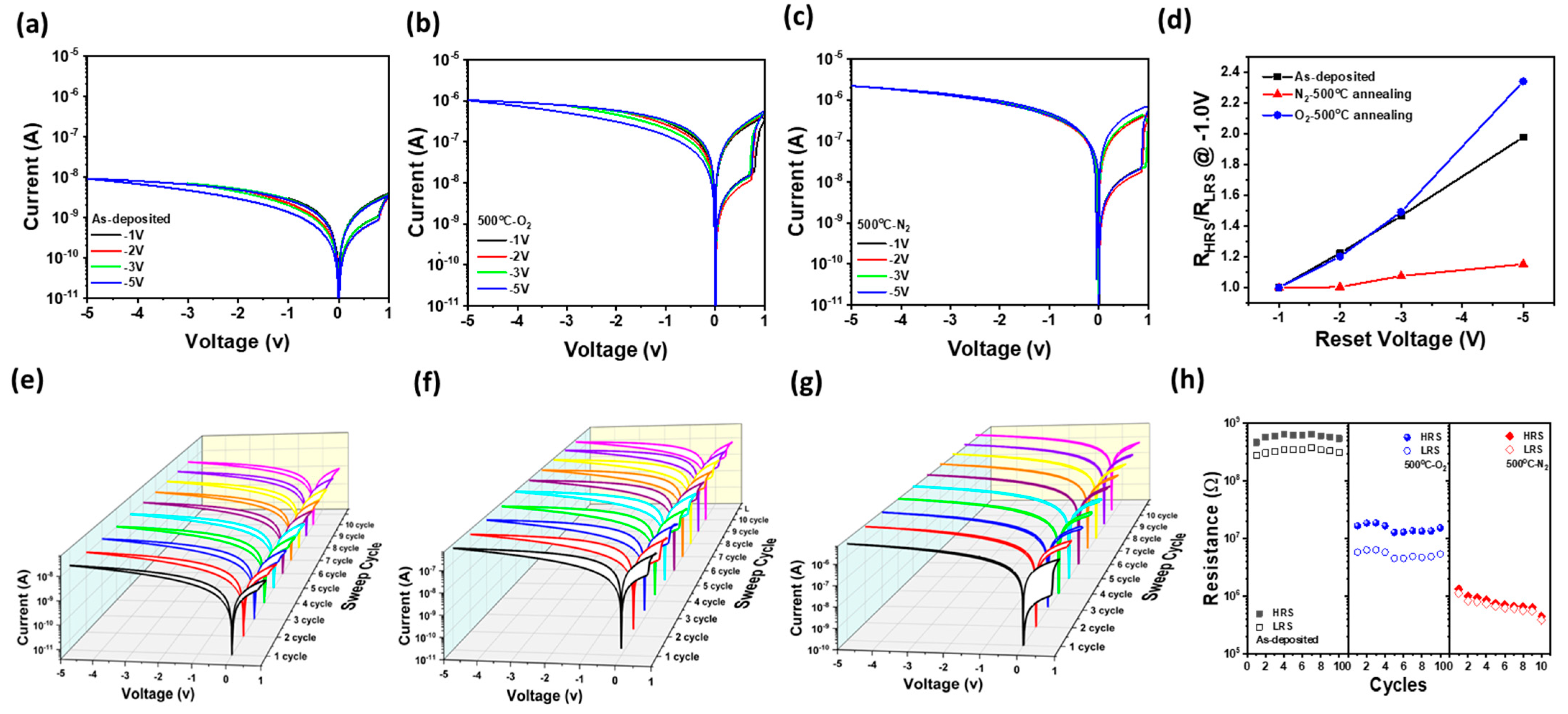
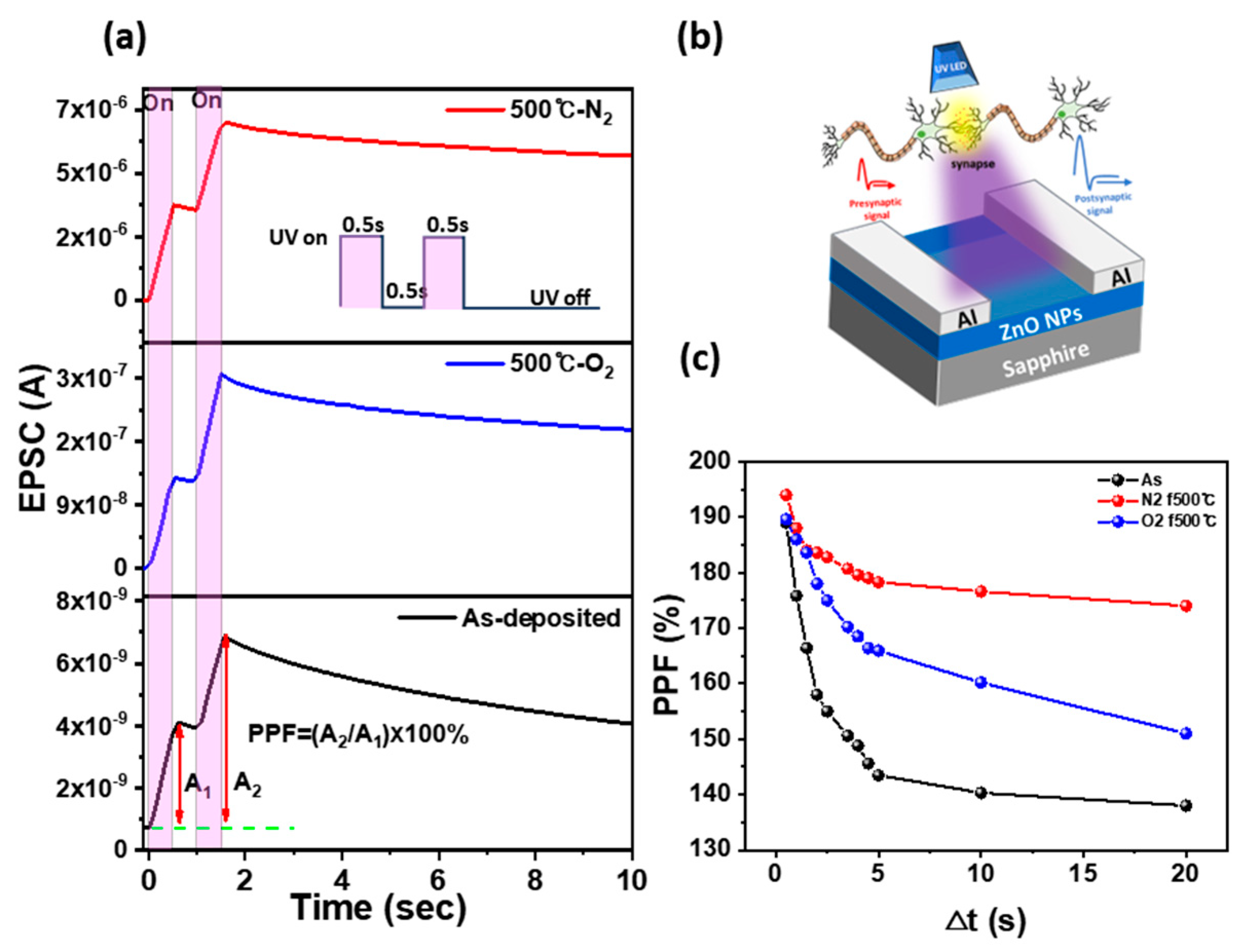
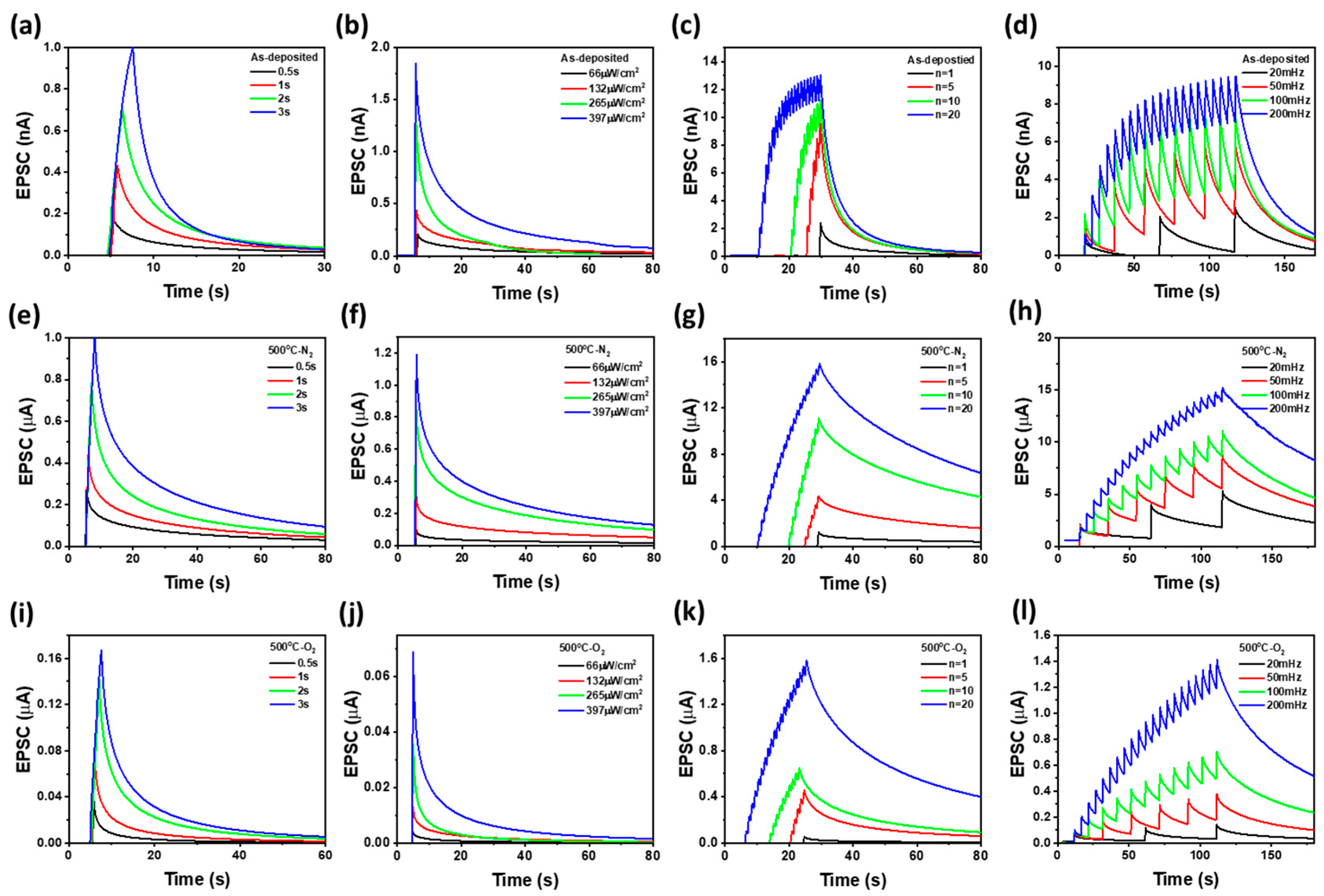
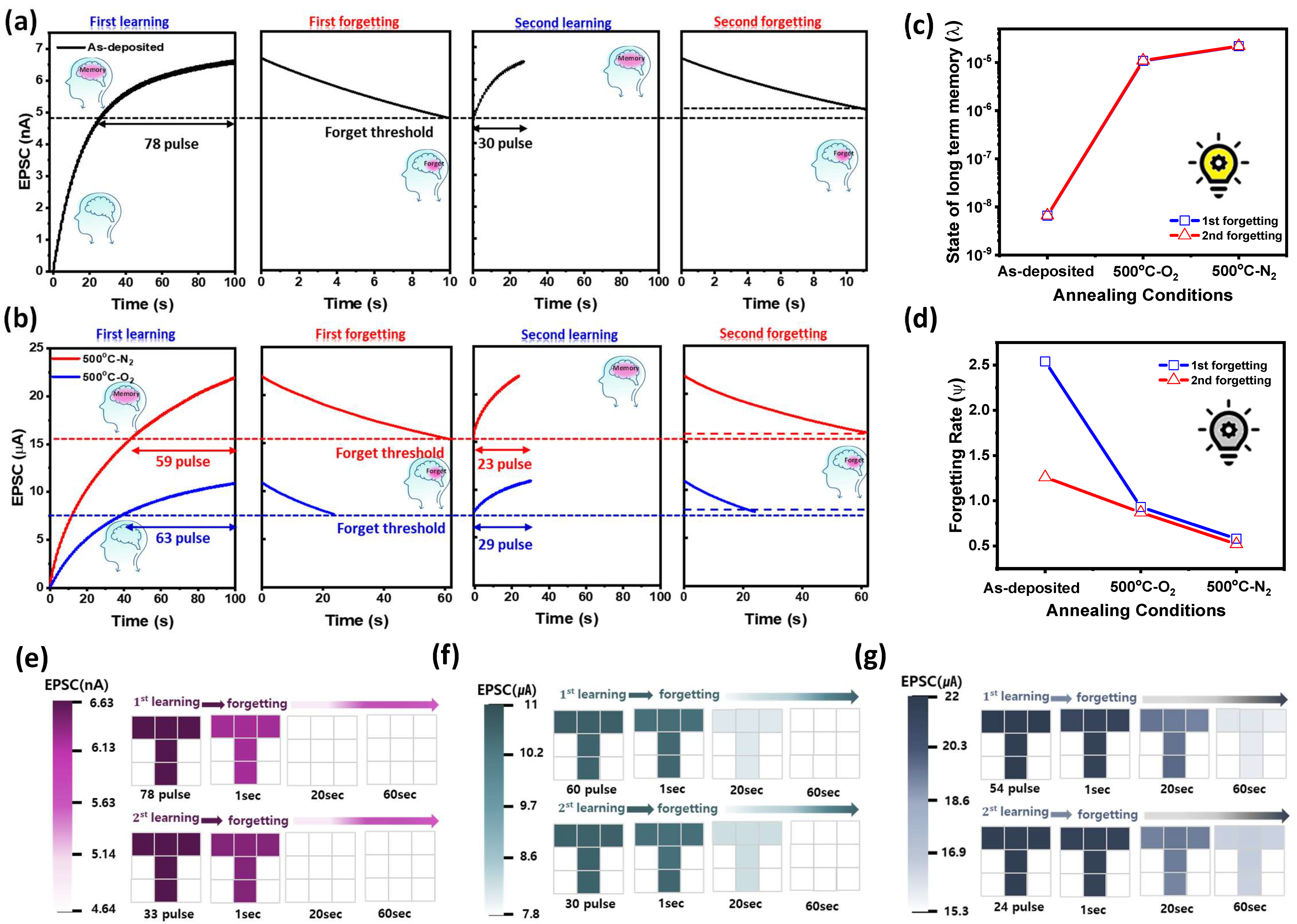
Disclaimer/Publisher’s Note: The statements, opinions and data contained in all publications are solely those of the individual author(s) and contributor(s) and not of MDPI and/or the editor(s). MDPI and/or the editor(s) disclaim responsibility for any injury to people or property resulting from any ideas, methods, instructions or products referred to in the content. |
© 2025 by the authors. Licensee MDPI, Basel, Switzerland. This article is an open access article distributed under the terms and conditions of the Creative Commons Attribution (CC BY) license (https://creativecommons.org/licenses/by/4.0/).
Share and Cite
Jeon, D.; Lee, S.H.; Lee, S.-N. Enhanced Long-Term In-Sensing Memory in ZnO Nanoparticle-Based Optoelectronic Synaptic Devices Through Thermal Treatment. Materials 2025, 18, 1321. https://doi.org/10.3390/ma18061321
Jeon D, Lee SH, Lee S-N. Enhanced Long-Term In-Sensing Memory in ZnO Nanoparticle-Based Optoelectronic Synaptic Devices Through Thermal Treatment. Materials. 2025; 18(6):1321. https://doi.org/10.3390/ma18061321
Chicago/Turabian StyleJeon, Dabin, Seung Hun Lee, and Sung-Nam Lee. 2025. "Enhanced Long-Term In-Sensing Memory in ZnO Nanoparticle-Based Optoelectronic Synaptic Devices Through Thermal Treatment" Materials 18, no. 6: 1321. https://doi.org/10.3390/ma18061321
APA StyleJeon, D., Lee, S. H., & Lee, S.-N. (2025). Enhanced Long-Term In-Sensing Memory in ZnO Nanoparticle-Based Optoelectronic Synaptic Devices Through Thermal Treatment. Materials, 18(6), 1321. https://doi.org/10.3390/ma18061321







